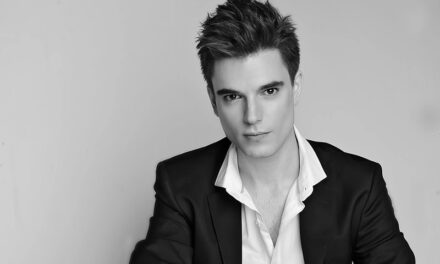Saturday night’s performance by the Greensboro Symphony Orchestra, led by music director Dmitry Sitkovetsky, highlighted the music of three great 19th century German composers: Robert Schumann (1810-56), Felix Mendelssohn (1809-47), and Johannes Brahms (1833-97). The concert was titled “Circle of Friends” because these three composers were connected to each other in wonderful ways (as Sitkovetsky explained after intermission). Mendelssohn was a great fan of the music of Schumann, and he premiered a number of his works with the Leipzig Gewandhaus Orchestra as well as some compositions of Robert’s wife, Clara. In addition, Schumann championed young Brahms (as well as Chopin) before he was famous. Finally, Brahms and Clara Schumann were friends for over 40 years, during which time Robert died insane in a mental institution.
Schumann was already seriously suffering when he penned the Overture from Manfred, named after the tragic hero of the poem Manfred: A dramatic poem by Lord Byron. Schumann conducted the first performance of the stark work, which conjures up the instability of both composer and hero, with the Leipzig Gewandhaus Orchestra.
Indeed, from the opening measures, the tension and inner conflict is obvious. The beginning is nebulous and mysterious. Different dramatic ideas are juxtaposed against each other in seething combinations, and few rays of hope are heard in the turbulent work. The GSO’s playing caught the dark, simmering quality with fire and passion.
Arguably the most famous 19th century violin concerto, and Mendelssohn’s only contribution to the genre, is the E minor, Op. 64; it was also the last concerto he wrote. It was a groundbreaking work for its time, even though written in a traditional tripartite form. The work contains harmonic and melodic links between movements, all of which are played without a pause. The soloist for this piece was the Russian-American Yevgeny Kutik, who previously appeared with the GSO in 2013.
The work begins almost immediately with the soloist, another unusual feature; Kutik’s subtle and nuanced playing was evident from those opening sounds. During the cadenza, one was wowed by both the violinist’s exquisite tone and his virtuosic playing, almost always coupled with expressive body movement. Sometimes the soloist’s playing was a whisper of a sound, but always with wonderful expansive freedom.
The outer sections of the slow movement (connected to the first movement by a solo bassoon note) are explorations of beauty. The middle section is a bit tense, clearly captured by orchestra and soloist. Sitkovetsky kept a close eye on the violinist, which resulted in fine ensemble. The final movement flies, and Mendelssohn’s trademark “elfin” music is very much at the forefront, especially evident from Kutik’s light and fast tempo and the exquisite playing from the winds. Again, Kutik could have pared down his sound (mostly matched by the orchestra) to an exquisite pianissimo, the softest of sounds. The audience erupted with enthusiastic applause at the brilliant conclusion.
Kutik treated the enamored audience to a solo encore, the Largo movement from J.S. Bach’s Sonata No. 3 in C for solo violin. Here, a lyric tune is frequently accompanied by double stops, expressively and freely played by the violinist.
Brahms said that his first symphony (C minor, Op. 68) took 21 years to compose, starting in 1854 and finally premiering in 1876; the compositional journey resulted in the composer’s first piano concerto (in D minor, Op. 15), which was created from some of the initial ideas along the way. The final result is a long, often tempestuous, and dark four-movement work.
The opening slow introduction, for example, features a mostly chromatic rising line in the strings over insistent timpani strokes, aspiring to break free, only to sink into the depths before the attempted ascent begins anew. When the fast section finally arrives some three minutes later, the tension simply takes another form. The GSO, under the strong guidance of Sitkovetsky, kept the reins of tension taut.
The more relaxed lyrical second movement featured some especially poignant playing from the winds and solo violin but included some simmering undercurrents. The grazioso third movement was elegant and smoothly played.
The slow introduction of the finale is cast in a minor key, which returns the stormy mood of the first movement. Pizzicato strings eventually lead to the brass’ intoning the “Alphorn” tune, which Brahms heard from an alpine shepherd – Brahms sketched this tune in a card sent to Clara Schumann.
The Allegro ensues in a major key, and the main tune is chorale-like. Many contemporaries remarked that the tune was reminiscent in character to Beethoven’s “Ode to Joy” in his Symphony No. 9, to which Brahms responded, “any ass can see that.” A multitude of emotions, both tender and dramatic, are explored in this movement, the longest of the four; the entire orchestra is put on display.
The GSO played with dedication and stamina, and the triumphant closing measures dissipated any lingering tensions. Sitkovetsky acknowledged several musicians for their finely wrought solos: Marjorie Bagley (violin), Ashley Barret (oboe), Kelly Burke (clarinet), and Robert Campbell (horn).
One last word about the Tanger Center acoustics. Sometimes the musicians closest to the edge of the stage (strings) were not as present and prominent as they were in other auditoriums such as Dana, UNCG, and even in the now-demolished War Memorial. The winds and brass (farther upstage) often overshadowed those closest to the audience, a disappointment for a “state-of-the-art” concert hall.











